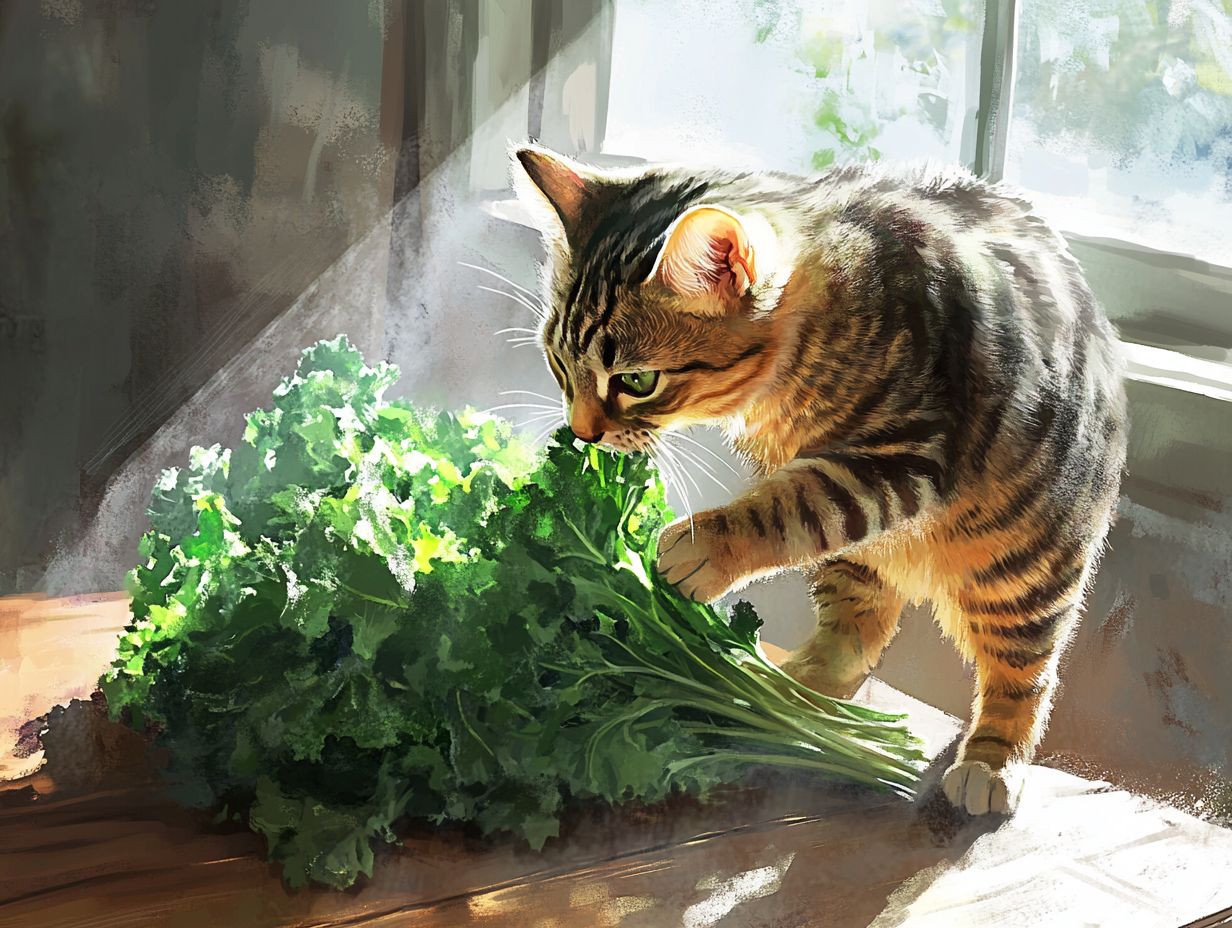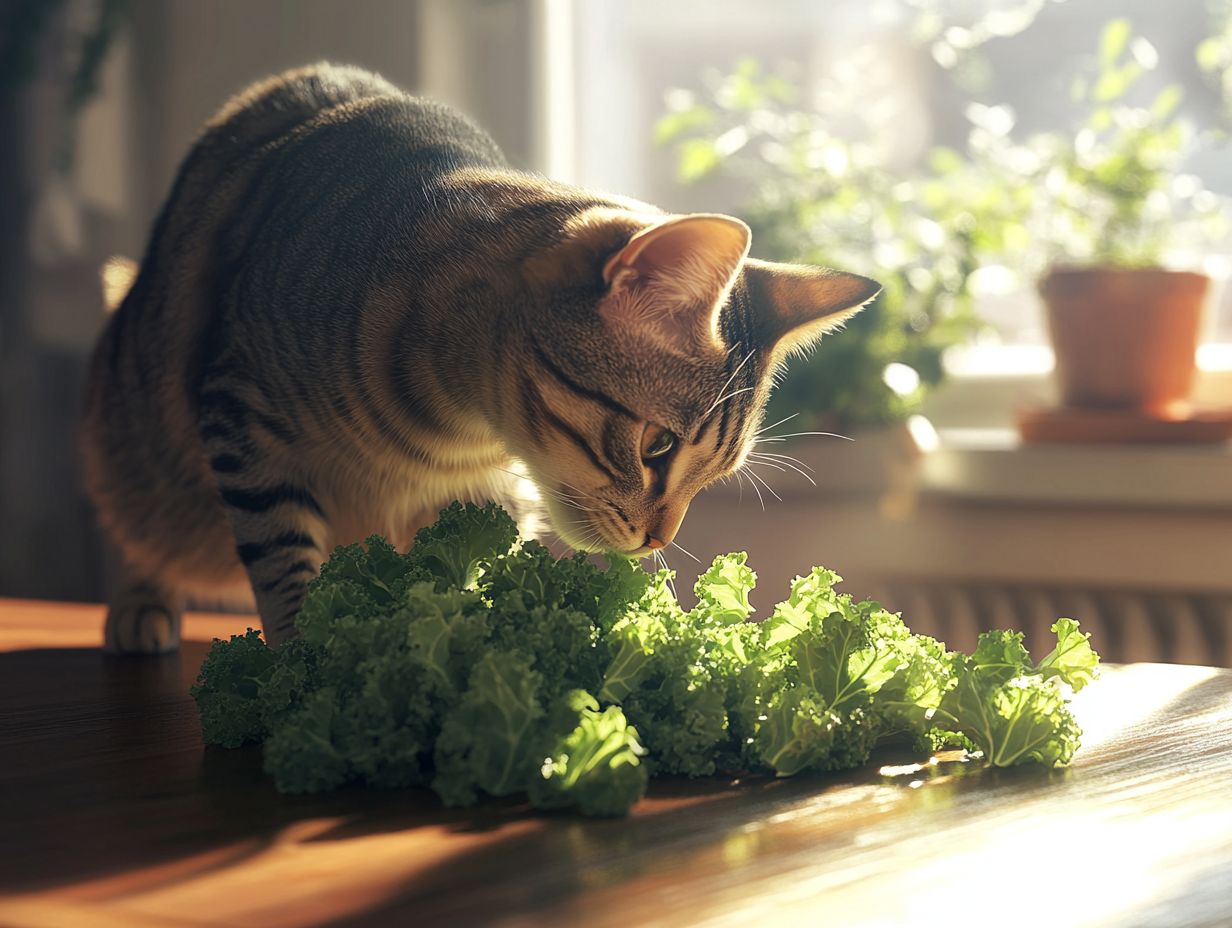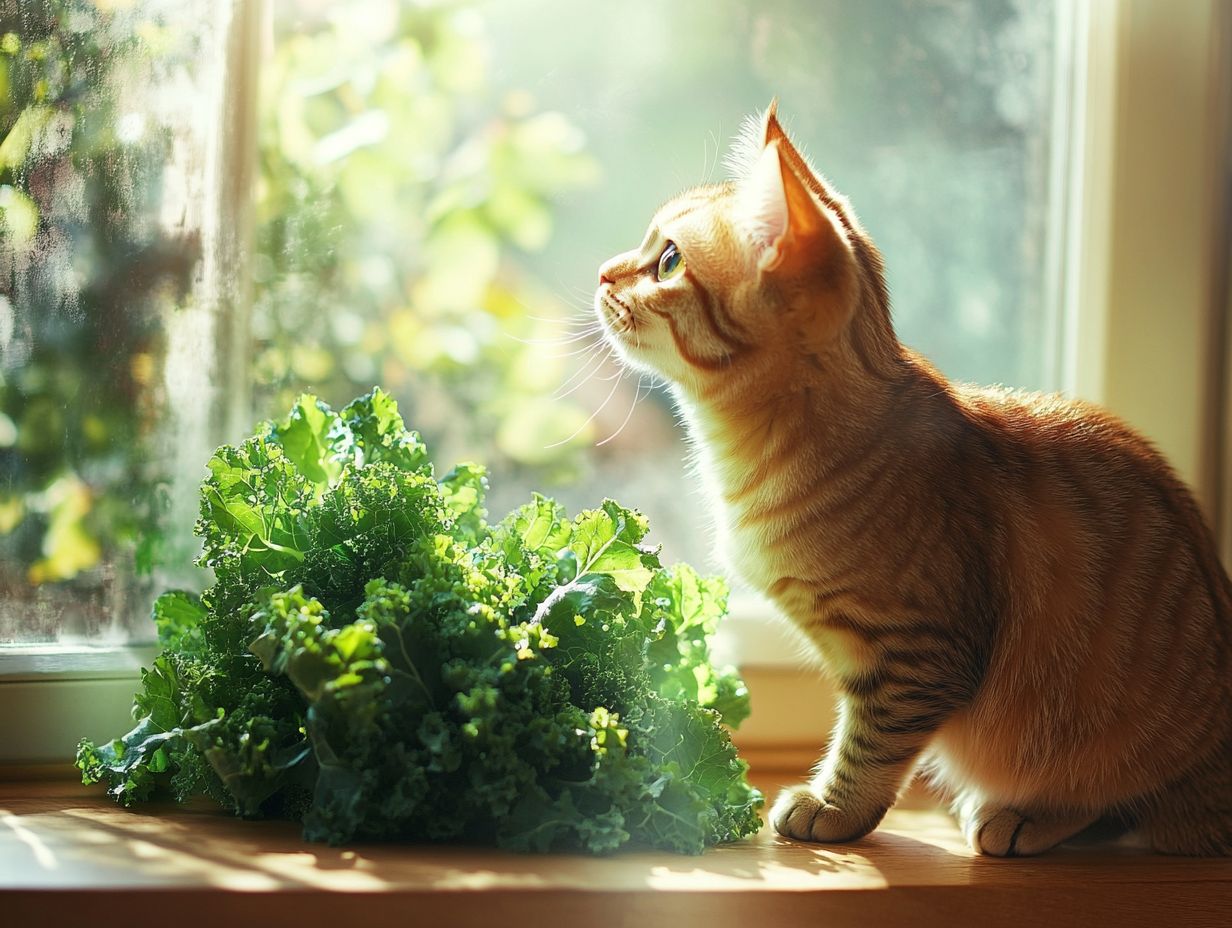Yes, kale can be safe for cats in moderation, but it’s essential to understand its risks and benefits. Many cat owners wonder if this leafy green is safe and beneficial for their pets. Understanding the impact of vegetables on pet health is crucial.
This article explores both the potential risks and health benefits of feeding kale to cats. From improving digestive health to boosting their immune system, it discusses how to safely incorporate kale into your cat’s diet with proper serving suggestions and offers alternatives, like spinach or cooked carrots, that pack a nutritional punch.
Whether you’re curious or considering a diet change for your kitty, this guide will help you make informed choices about incorporating leafy greens into their natural diet.
Frequently Asked Questions
Can cats eat kale?
Yes, cats can eat kale in moderation as part of a balanced diet.
What are the health benefits of kale for cats?
- Vitamin A: Supports vision and immune function.
- Vitamin C: Acts as an antioxidant, promoting overall health.
- Vitamin K: Essential for blood clotting and bone health.
- Calcium: Important for strong bones and teeth.
- Antioxidants: Help reduce inflammation and support overall well-being.
Is kale safe for cats to eat?
Yes, kale is generally safe for cats to eat, but it is important to introduce it slowly and in small amounts to avoid any tummy upset.
Key Takeaways:

Is Kale Safe for Cats?
Kale is often considered a superfood for humans, but is it safe for cats? While kale is rich in fiber, vitamins, and antioxidants, there are important considerations regarding your cat’s health.
As cats are meat-eaters, it is essential to understand whether kale fits into their natural diet. This article will explore the safety of kale for cats, examining the potential risks and benefits of this leafy green, such as its high alkaline content, while providing pet owners with valuable information on its inclusion in a balanced diet.
Potential Risks and Benefits
Feeding kale to cats carries certain risks, including the potential for tummy upset or obstruction, as well as serious side effects from the oxalates and isothiocyanates found in kale. However, there are notable health benefits associated with feeding kale to cats, such as improved digestion, enhanced urinary health, and a strengthened immune system.
Kale is rich in vitamins A, C, and K, along with fiber and antioxidants. These nutrients can help regulate a cat’s digestive system and bolster their immune system, aiding in the prevention of infections and other diseases.
Nutritional Benefits
Incorporating pet-friendly vegetables such as kale into your cat’s diet can be beneficial. Kale offers several health advantages, including improved digestive health and a stronger immune system.
When served in appropriate portions and prepared correctly, kale can be a healthy food for your cat. It is rich in fiber, antioxidants, and vitamins A, C, and K, making it a nutritious addition.
However, pet owners should be mindful of serving sizes and preparation methods to prevent any adverse effects. Offer no more than a teaspoon of finely chopped kale for every five pounds of your cat’s weight once or twice a week.
How to Prepare Kale for Cats
To properly prepare kale for your cat, steam or boil it to reduce oxalates and serve small, chopped portions to prevent choking. Always consult your veterinarian if you are unsure about making changes to your cat’s diet.
Improving Digestive Health

Kale enhances the digestive health of cats, primarily due to its high fiber content. The fiber in kale helps normalize bowel movements and promotes quicker elimination.
Understanding the importance of fiber in a cat’s diet is essential, as a healthy digestive tract contributes to a cat’s overall well-being. A balanced diet rich in fiber will help maintain a healthy weight and increase energy levels.
Boosting Immune System
Kale supports digestion and enhances immunity thanks to its high antioxidant content. These antioxidants protect a cat’s body from free radicals—unstable molecules that can cause cellular damage.
Potential Health Warnings
Cats with kidney issues should avoid high-oxalate foods like kale. Always consult with your veterinarian regarding your cat’s specific health conditions before introducing new foods.
Conclusion
While kale can offer health benefits, always consult your veterinarian before making significant changes to your cat’s diet. Understanding both the risks and rewards of incorporating kale into their diet is essential for your pet’s health. Monitor your cat for signs of tummy upset, such as vomiting or diarrhea, when introducing new foods.
How to Incorporate Kale into a Cat’s Diet
The best way to feed kale to a cat is to cook it and serve it in small amounts. A suggested portion is 1 teaspoon of finely chopped or steamed kale per 5 pounds of body weight. Cats should not consume large quantities of vegetables. Cooking kale, especially by steaming, can make it easier for them to digest and preserve more nutrients compared to boiling.
Proper Preparation and Serving Suggestions
Proper preparation and serving sizes of kale are crucial when introducing this vegetable into a cat’s diet. Different cooking methods can impact its digestibility; for instance, steaming the leaves makes them easier to chew. Conversely, boiling can lead to nutrient loss.
Chopping the kale into smaller pieces can also improve consumption and digestion. Remember, kale should only be given in moderation, as excessive amounts can lead to tummy upset.
A small portion, such as a teaspoon of finely chopped or steamed kale mixed into their food, can serve as a healthy treat without overburdening their digestive system.
Alternatives to Kale for Cats

Healthy alternatives to kale for cats include several nutritious vegetables:
- Spinach: Excellent source of iron, antioxidants, and vitamins A, C, and K. Best served cooked and chopped for easier digestion.
- Cabbage: Rich in fiber and vitamin K, beneficial for digestion when steamed or boiled.
- Broccoli: Contains various healthy nutrients and should be cooked for improved digestibility.
Other Nutritious Greens for Cats
Besides kale, other healthy greens can be beneficial. For instance, spinach is rich in vitamins A, C, and K, supporting a cat’s immune system. Broccoli is high in fiber, aiding digestion. Additionally, carrots and cabbage are nutritious options.
These greens can be mixed into their regular meals or offered as treats, ensuring your cat enjoys a varied diet while reaping health benefits. Gradually introducing these leafy greens can enhance their overall nutritional intake without overwhelming their system. For more information, you can read about the health benefits of kale for cats.
Disclaimer
The information provided in this article is not a substitute for professional veterinary advice. Always consult your veterinarian regarding your cat’s specific dietary needs and health concerns.
Are there any cats that should not eat kale?
Cats with certain medical conditions, such as kidney disease or a history of bladder stones, should avoid eating kale. High levels of oxalates found in kale can be harmful to these cats. Always consult your veterinarian before introducing kale to your cat’s diet.
Benefits of Kale
Kale is rich in essential nutrients, including vitamins A, C, and K, contributing to your cat’s overall health when offered in moderation. However, remember that kale should play a limited role in your cat’s diet, primarily as an occasional treat.
Feeding Tips
When offering kale to your cat, practical feeding tips are essential. Offer no more than a teaspoon of finely chopped kale as an occasional treat. To make it easier for your cat to digest, consider steaming or sautéing the kale before serving.
In conclusion, while kale can be offered as a treat in moderation, always consult with your veterinarian first to ensure it is safe for your cat’s specific health needs.